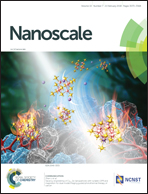A mineralized cell-based functional platform: construction of yeast cells with biogenetic intracellular hydroxyapatite nanoscaffolds†
Abstract
A unique mineralized cell-based functional platform with biogenic intracellular hydroxyapatite nanoscaffolds (nHAP@yeasts) has been intelligently constructed using a biomimetic mineralization approach. Such a platform not only preserves the nature and functions of cells but also possesses intracellular nanoscaffolds, which endow the mineralized cells with novel functions in biological and nanotechnological applications. Benefiting from their unique organism shell and inorganic core, the nHAP@yeasts are biocompatible and have a large loading capacity for drugs. Such anaerobic microorganisms could be beneficial as drug carriers for the effective delivery and release of loaded drugs in tumors because they prefer to locate and grow in reduced oxygen surroundings. A functional investigation indicated that the nHAP@yeasts, functionalized with folic acid (nHAP@yeasts-FA) as cell-based carriers, showed dual responsive release profiles based on the FA dependency of tumors and the pH-sensitivity of the HAP nanoparticles, and they significantly inhibited tumor growth while displaying low toxicity. This study for the first time provides a bio-friendly strategy to biosynthesize a mineralized cell-based functional platform with biogenic intracellular nanominerals (carbonate, sulfides, selenides, metals, etc.) for biological and nanotechnological application.



 Please wait while we load your content...
Please wait while we load your content...